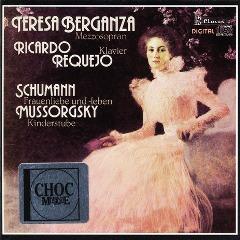Schumann: Frauenliebe und-leben - Mussorgsky: Kinderstube (1982)
Schumann: Frauenliebe und-leben - Mussorgsky: Kinderstube (1982)

Robert Schumann 1810-1856: Frauenliebe Und -Leben Op. 42 21:15 A1 I Seit Ich Ihn Gesehen A2 II Er, Der Herrlichste Von Allen A3 III Ich Kann's Nicht Fassen, Nicht Glauben A4 IV Du Ring An Meinem Finger A5 V Helft Mir, Ihr Schwestern A6 VI Süsser Freund, Du Blickest A7 VII An Meinem Herzen, An Meiner Brust A8 VIII Nun Hast Du Mir Den Ersten Schmerz Getan Modest Mussorgsky 1839-1881: Die Kinderstube, Episoden Aus Dem Kinderleben 17:12 B1 I Mit Der Kinderfrau B2 II Im Winkel B3 III Der Käfer B4 IV Mit Der Puppe B5 V Vor Dem Schlafengehen B6 VI Ritt Auf Dem Steckenpferd B7 VII Kater Murr Teresa Berganza – mezzo-soprano Ricardo Requejo – piano
Frauenliebe und -leben (A Woman's Love and Life) is a cycle of poems by Adelbert von Chamisso, written in 1830. They describe the course of a woman's love for her man, from her point of view, from first meeting through marriage to his death, and after. Schumann wrote his setting in 1840, a year in which he wrote so many lieder (including three other song cycles: Liederkreis Op. 24 and Op. 39, Dichterliebe), that it is known as his "year of song". There are eight poems in his cycle. Schumann's choice of text was very probably inspired in part by events in his personal life. He had been courting Clara Wieck, but had failed to get her father's permission to marry her. In 1840, after a legal battle to make such permission unnecessary, he finally married her.
This is an immensely sophisticated and masterful song cycle. Mussorgsky was one of the first composers to fashion music from speech patterns, and in least one of the songs in this collection, "The Nanny," that technique is in evidence. He first began to develop this method with the songs "Darling Savishna," "You Drunken Sot," and "The Seminarist," all from 1866. But what Mussorgsky was striving for in "The Nanny" goes beyond mere reproduction of speech sounds: he attempts to express musically the feelings and ideas of the child.
The composer used his own texts in this cycle and the subject matter, of course, deals with the world of children, as the titles of the seven songs suggest. Yet, the music is not for children; it is formally, thematically, and harmonically as advanced as almost anything in its genre from that era. In certain ways, these songs are a vocal parallel to Schumann's keyboard collection Kinderszenen (Scenes of Childhood) (1838), which also represents an adult view of a children's world. But Mussorgsky's effort here was even more innovative and radical in its time than Schumann's work.
download: uploaded yandex 4shared mediafire solidfiles mega zalivalka filecloudio anonfiles oboom








